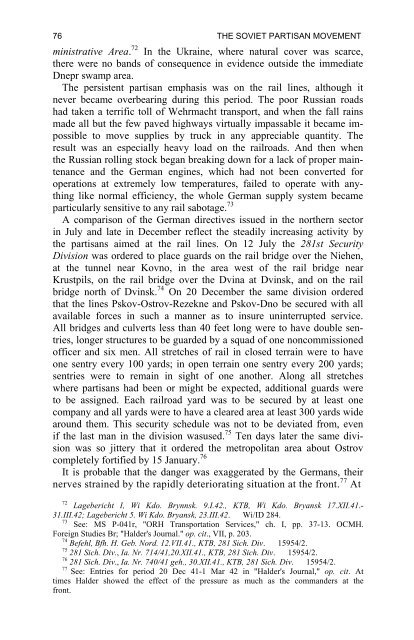the soviet partisan movement 1941-1944 by edgar m. howell
the soviet partisan movement 1941-1944 by edgar m. howell
the soviet partisan movement 1941-1944 by edgar m. howell
Create successful ePaper yourself
Turn your PDF publications into a flip-book with our unique Google optimized e-Paper software.
76 THE SOVIET PARTISAN MOVEMENT<br />
ministrative Area. 72 In <strong>the</strong> Ukraine, where natural cover was scarce,<br />
<strong>the</strong>re were no bands of consequence in evidence outside <strong>the</strong> immediate<br />
Dnepr swamp area.<br />
The persistent <strong>partisan</strong> emphasis was on <strong>the</strong> rail lines, although it<br />
never became overbearing during this period. The poor Russian roads<br />
had taken a terrific toll of Wehrmacht transport, and when <strong>the</strong> fall rains<br />
made all but <strong>the</strong> few paved highways virtually impassable it became impossible<br />
to move supplies <strong>by</strong> truck in any appreciable quantity. The<br />
result was an especially heavy load on <strong>the</strong> railroads. And <strong>the</strong>n when<br />
<strong>the</strong> Russian rolling stock began breaking down for a lack of proper maintenance<br />
and <strong>the</strong> German engines, which had not been converted for<br />
operations at extremely low temperatures, failed to operate with anything<br />
like normal efficiency, <strong>the</strong> whole German supply system became<br />
particularly sensitive to any rail sabotage. 73<br />
A comparison of <strong>the</strong> German directives issued in <strong>the</strong> nor<strong>the</strong>rn sector<br />
in July and late in December reflect <strong>the</strong> steadily increasing activity <strong>by</strong><br />
<strong>the</strong> <strong>partisan</strong>s aimed at <strong>the</strong> rail lines. On 12 July <strong>the</strong> 281st Security<br />
Division was ordered to place guards on <strong>the</strong> rail bridge over <strong>the</strong> Niehen,<br />
at <strong>the</strong> tunnel near Kovno, in <strong>the</strong> area west of <strong>the</strong> rail bridge near<br />
Krustpils, on <strong>the</strong> rail bridge over <strong>the</strong> Dvina at Dvinsk, and on <strong>the</strong> rail<br />
bridge north of Dvinsk. 74 On 20 December <strong>the</strong> same division ordered<br />
that <strong>the</strong> lines Pskov-Ostrov-Rezekne and Pskov-Dno be secured with all<br />
available forces in such a manner as to insure uninterrupted service.<br />
All bridges and culverts less than 40 feet long were to have double sentries,<br />
longer structures to be guarded <strong>by</strong> a squad of one noncommissioned<br />
officer and six men. All stretches of rail in closed terrain were to have<br />
one sentry every 100 yards; in open terrain one sentry every 200 yards;<br />
sentries were to remain in sight of one ano<strong>the</strong>r. Along all stretches<br />
where <strong>partisan</strong>s had been or might be expected, additional guards were<br />
to be assigned. Each railroad yard was to be secured <strong>by</strong> at least one<br />
company and all yards were to have a cleared area at least 300 yards wide<br />
around <strong>the</strong>m. This security schedule was not to be deviated from, even<br />
if <strong>the</strong> last man in <strong>the</strong> division wasused. 75 Ten days later <strong>the</strong> same division<br />
was so jittery that it ordered <strong>the</strong> metropolitan area about Ostrov<br />
completely fortified <strong>by</strong> 15 January. 76<br />
It is probable that <strong>the</strong> danger was exaggerated <strong>by</strong> <strong>the</strong> Germans, <strong>the</strong>ir<br />
nerves strained <strong>by</strong> <strong>the</strong> rapidly deteriorating situation at <strong>the</strong> front. 77 At<br />
72<br />
Lagebericht I, Wi Kdo. Brynnsk. 9.I.42., KTB, Wi Kdo. Bryansk 17.XII.41.-<br />
31.III.42; Lagebericht 5. Wi Kdo. Bryansk, 23.III.42. Wi/ID 284.<br />
73<br />
See: MS P-041r, "ORH Transportation Services," ch. I, pp. 37-13. OCMH.<br />
Foreign Studies Br; "Halder's Journal." op. cit., VII, p. 203.<br />
74<br />
Befehl, Bfh. H. Geb. Nord. 12.VII.41., KTB, 281 Sich. Div. 15954/2.<br />
75<br />
281 Sich. Div., Ia. Nr. 714/41,20.XII.41., KTB, 281 Sich. Div. 15954/2.<br />
76<br />
281 Sich. Div., Ia. Nr. 740/41 geh., 30.XII.41., KTB, 281 Sich. Div. 15954/2.<br />
77<br />
See: Entries for period 20 Dec 41-1 Mar 42 in "Halder's Journal," op. cit. At<br />
times Halder showed <strong>the</strong> effect of <strong>the</strong> pressure as much as <strong>the</strong> commanders at <strong>the</strong><br />
front.
















